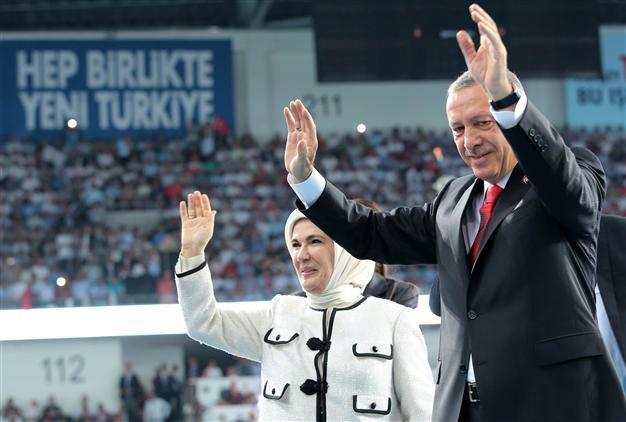A portrait: Erdoğan’s epic political journey
ANKARA Emine Kart / Serkan Demirtaş

Recep Tayyip Erdogan (R) and his wife Emine Erdogan wave to AK Party's supporters as they attend on Aug. 27. AFP Photo / Pool / Raşit Erdoğan
One shall give credit where credit is due: Turkey’s President-elect Recep Tayyip Erdoğan has proven he could deliver most of his promises after having entered politics as a full-time assignment back in 1994, when he was elected mayor of the country’s largest city, Istanbul.
Yet, what made his charisma and sheer force of personality throughout the country was an unfortunate incident. He left mayoral office in March 1999 after four-and-a-half years in order to serve four months in jail, as he was convicted of inciting committing a crime and inciting religious or racial hatred because of a poem he read during rally in Siirt in 1997.
Erdoğan’s political life has always been an epic journey. He made a flamboyant return in March 2003 after winning a vacant seat in Siirt in a by-election because he was still banned when his Justice and Development Party (AKP) came to power for the first time in November 2002.
Assertive and reformistAs a pragmatic leader, one of the first announcements Erdoğan made at the Prime Ministry office was a pledge to comply with the IMF-led economic program in a bid to inject assurance to world markets and pursue political reforms for the democratization of Turkey with the aim to draw “a credible partner” to the West, particularly to the United States and the European Union.
Such a stance played a significant role in paving the way for beginning negotiations for Turkey’s full membership to the EU in 2005, marking a milestone in the country’s long march toward integration with Europe. High growth rates, reduced inflation and increase in trade volume were key constituents of Erdoğan’s success story in this period.
Also along this period, he had to fight against the staunchly secular army and the judiciary, especially when he moved to let Abdullah Gül, whose wife wears a headscarf, be elected president. Erdoğan did not give up against the army’s reaction and the judiciary’s attempt to shut down his AKP; and managed to keep the military in its barracks and re-organize civil-military relations to the advantage of elected governments.
It was then when the Western media began frequently depicting the prime minister as a reformist, taboo-breaking leader that turned Turkey into a model country promoting universal principles of democracy, rule of law and human rights for its region. Erdoğan was shown among the top five world leaders that U.S. President Barack Obama was in full confidence of in this period.
Erdoğan entered his third parliamentary elections with this spirit in 2011 and increased his votes to nearly 50 percent in a historic success.
Authoritarian, one-man ruleAuthoritarian inclinations began being attributed to Erdoğan after his gradually noticeable attempts to inactivate checks and balance mechanisms within the state system, with his growing intolerance toward his dissidents having become more concrete after he received every other person’s vote.
At the center of criticism against Erdoğan was the fact that he started to use more divisive and tense language such as “us and them” and insults toward those who do not share conservative lifestyles were at the center of criticisms against him.
Such non-conciliatory rhetoric against protestors in Istanbul in 2013 caused weeks of clashes between activists and security forces in the country’s largest mass demonstrations over the years. Erdoğan’s instruction to the security forces to crack down on even peaceful activities caused uproar in the world as well.
Another important development in this latest period was the launch of massive corruption and graft operations engulfing the prime minister, his family and some of his ministers in late 2013.
Instead of an effective investigation on the claims, Erdoğan chose to fight against the police and judiciary members carrying out the operation on the grounds that they were part of what he called the “parallel state” under the influence of Fethullah Gülen, a self-exiled U.S.-based Islamic scholar.
Empowering his intelligence organization, banning Twitter and YouTube in 2013 carried him to the Western media’s list of the world’s authoritarian leaders.
Arab Street, Arab Spring
It was January 2009 when Erdoğan walked out of a January meeting of the World Economic Forum (WEF) in Davos, Switzerland, after a heated exchange with then-President Shimon Peres of Israel, telling him, “When it comes to killing, you know very well how to kill.” His remarks were referring to Israel’s offensive in the Gaza Strip and prompted considerable admiration for him on the Arab streets.
Throughout the Arab Spring, however, an aggressive policy dominated by sectarian tendencies cost a high price, as Turkey can no longer talk with the region’s prominent countries, such as Iraq, Syria, Israel and Egypt.
A vicious circleWithin its first year in power, the AKP government led by Erdoğan had to tackle the “Hood Incident” of July 4, 2003, the day when U.S. troops raided the Turkish military’s liaison office in Sulaymaniyah and placed hoods on 11 Turkish Special Forces soldiers, detaining them in harsh conditions for days.
An unfortunate twist of fate, a day after Erdoğan ended his term of office as the prime minister and took oath as the president; today, Turkey marks its 79th day since 49 Turkish nationals were kidnapped from its consulate-general in Mosul by jihadist militants.
Thus, as it has been the case when his political career as the prime minister began, no bed of roses is waiting for Erdoğan at the presidential office either.
